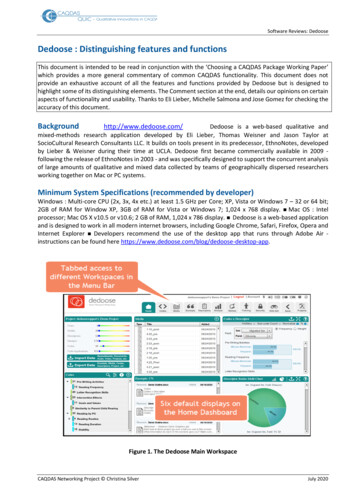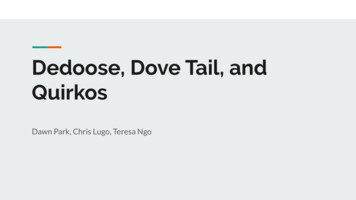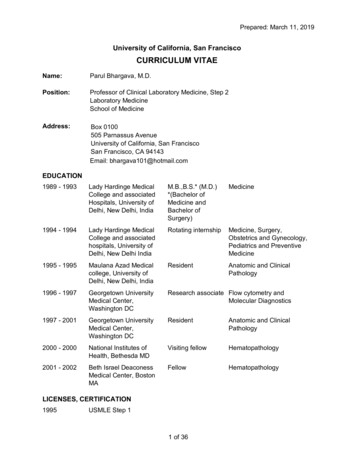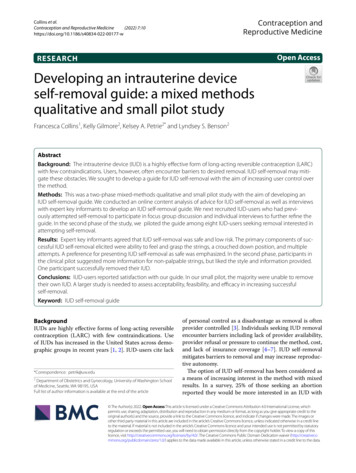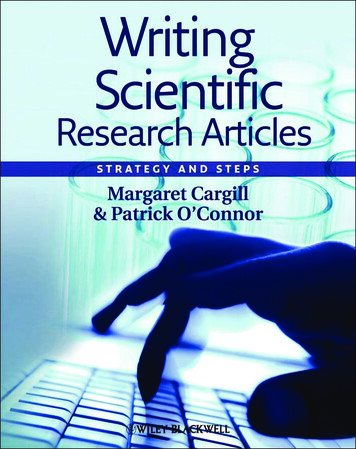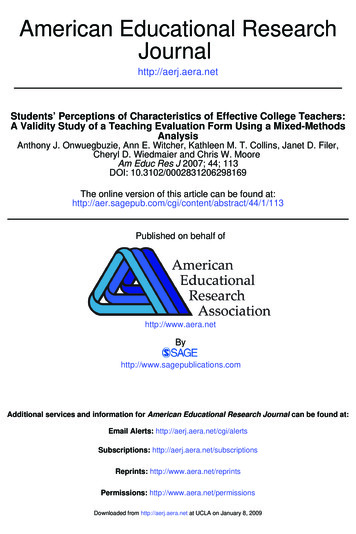
Transcription
American Educational ResearchJournalhttp://aerj.aera.netStudents’ Perceptions of Characteristics of Effective College Teachers:A Validity Study of a Teaching Evaluation Form Using a Mixed-MethodsAnalysisAnthony J. Onwuegbuzie, Ann E. Witcher, Kathleen M. T. Collins, Janet D. Filer,Cheryl D. Wiedmaier and Chris W. MooreAm Educ Res J 2007; 44; 113DOI: 10.3102/0002831206298169The online version of this article can be found 1/113Published on behalf .comAdditional services and information for American Educational Research Journal can be found at:Email Alerts: http://aerj.aera.net/cgi/alertsSubscriptions: http://aerj.aera.net/subscriptionsReprints: http://www.aera.net/reprintsPermissions: http://www.aera.net/permissionsDownloaded from http://aerj.aera.net at UCLA on January 8, 2009
American Educational Research JournalMarch 2007, Vol. 44, No. 1, pp. 113–160DOI: 10.3102/0002831206298169 2007 AERA. http://aerj.aera.netStudents’ Perceptions of Characteristics ofEffective College Teachers: A Validity Studyof a Teaching Evaluation Form Using aMixed-Methods AnalysisAnthony J. OnwuegbuzieUniversity of South FloridaAnn E. WitcherUniversity of Central ArkansasKathleen M. T. CollinsUniversity of Arkansas, FayettevilleJanet D. FilerCheryl D. WiedmaierChris W. MooreUniversity of Central ArkansasThis study used a multistage mixed-methods analysis to assess the contentrelated validity (i.e., item validity, sampling validity) and construct-relatedvalidity (i.e., substantive validity, structural validity, outcome validity, generalizability) of a teaching evaluation form (TEF) by examining students’ perceptions of characteristics of effective college teachers. Participants were 912undergraduate and graduate students (10.7% of student body) from variousacademic majors enrolled at a public university. A sequential mixed-methodsanalysis led to the development of the CARE-RESPECTED Model of TeachingEvaluation, which represented characteristics that students considered to reflecteffective college teaching—comprising four meta-themes (communicator, advocate, responsible, empowering) and nine themes (responsive, enthusiast, studentcentered, professional, expert, connector, transmitter, ethical, and director).Three of the most prevalent themes were not represented by any of the TEF items;also, endorsement of most themes varied by student attribute (e.g., gender, age),calling into question the content- and construct-related validity of the TEFscores.KEYWORDS: college teaching, mixed methods, teaching evaluation form,validityDownloaded from http://aerj.aera.net at UCLA on January 8, 2009
Onwuegbuzie et al.In this era of standards and accountability, institutions of higher learninghave increased their use of student rating scales as an evaluative component of the teaching system (Seldin, 1993). Virtually all teachers at most universities and colleges are either required or expected to administer to theirstudents some type of teaching evaluation form (TEF) at one or more pointsduring each course offering (Dommeyer, Baum, Chapman, & Hanna, 2002;Onwuegbuzie, Daniel, & Collins, 2006, in press). Typically, TEFs serve as formative and summative evaluations that are used in an official capacity byadministrators and faculty for one or more of the following purposes: (a) tofacilitate curricular decisions (i.e., improve teaching effectiveness); (b) to formulate personnel decisions related to tenure, promotion, merit pay, and thelike; and (c) as an information source to be used by students as they selectfuture courses and instructors (Gray & Bergmann, 2003; Marsh & Roche,1993; Seldin, 1993).TEFs were first administered formally in the 1920s, with students at theUniversity of Washington responding to what is credited as being the firstANTHONY J. ONWUEGBUZIE is a professor of educational measurement and researchin the Department of Educational Measurement and Research, College of Education,University of South Florida, 4202 East Fowler Avenue, EDU 162, Tampa, FL 336207750; e-mail: tonyonwuegbuzie@aol.com. He specializes in mixed methods, qualitative research, statistics, measurement, educational psychology, and teacher education.ANN E. WITCHER is a professor in the Department of Middle/Secondary Educationand Instructional Technologies, University of Central Arkansas, 104D Mashburn Hall,Conway, AR 72035; e-mail: annw@uca.edu. Her specialization area is educationalfoundations, especially philosophy of education.KATHLEEN M. T. COLLINS is an associate professor in the Department of Curriculum & Instruction, University of Arkansas, 310 Peabody Hall, Fayetteville, AR 72701;e-mail: kcollinsknob@cs.com. Her specializations are special populations, mixedmethods research, and education of postsecondary students.JANET D. FILER is an assistant professor in the Department of Early Childhoodand Special Education, University of Central Arkansas, 136 Mashburn Hall, Conway,AR 72035; e-mail: janetf@uca.edu. Her specializations are families, technology, personnel preparation, educational assessment, educational programming, and youngchildren with disabilities and their families.CHERYL D. WIEDMAIER is an assistant professor in the Department of Middle/Secondary Education and Instructional Technologies, University of Central Arkansas,104B Mashburn Hall, Conway, AR 72035; e-mail: cherylw@uca.edu. Her specializations are distance teaching/learning, instructional technologies, and training/adulteducation.CHRIS W. MOORE is pursing a master of arts in teaching degree at the Departmentof Middle/Secondary Education and Instructional Technologies, University of CentralArkansas, Conway, AR 72035; e-mail: chmoor@tcworks.net. Special interests focus onintegrating 20 years of information technology experience into the K-12 learningenvironment and sharing with others the benefits of midcareer conversion to the education profession.114Downloaded from http://aerj.aera.net at UCLA on January 8, 2009
Characteristics of Effective College TeachersTEF (Guthrie, 1954; Kulik, 2001). Ory (2000) described the progression ofTEFs as encompassing several distinct periods that marked the perceivedneed for information by a specific audience (i.e., stakeholder). Specifically,in the 1960s, student campus organizations collected TEF data in anattempt to meet students’ demands for accountability and informed courseselections. In the 1970s, TEF ratings were used to enhance faculty development. In the 1980s to 1990s, TEFs were used mainly for administrativepurposes rather than for student or faculty improvement. In recent years,as a response to the increased focus on improving higher education andrequiring institutional accountability, the public, the legal community,and faculty are demanding TEFs with greater trustworthiness and utility(Ory, 2000).Since its inception, the major objective of the TEF has been to evaluatethe quality of faculty teaching by providing information useful to bothadministrators and faculty (Marsh, 1987; Seldin, 1993). As observed by Seldin(1993), TEFs receive more scrutiny from administrators and faculty than doother measures of teaching effectiveness (e.g., student performance, classroom observations, faculty self-reports).Used as a summative evaluation measure, TEFs serve as an indicator ofaccountability by playing a central role in administrative decisions about faculty tenure, promotion, merit pay raises, teaching awards, and selection offull-time and adjunct faculty members to teach specific courses (Kulik, 2001).As a formative evaluation instrument, faculty may use data from TEFs toimprove their own levels of instruction and those of their graduate teachingassistants. In turn, TEF data may be used by faculty and graduate teachingassistants to document their teaching when applying for jobs. Furthermore,students can use information from TEFs as one criterion for making decisionsabout course selection or deciding between multiple sections of the samecourse taught by different teachers. Also, TEF data regularly are used to facilitate research on teaching and learning (Babad, 2001; Gray & Bergmann,2003; Kulik, 2001; Marsh, 1987; Marsh & Roche, 1993; Seldin, 1993; Spencer& Schmelkin, 2002).Although TEF forms might contain one or more open-ended itemsthat allow students to disclose their attitudes toward their instructors’ teaching style and efficacy, these instruments typically contain either exclusivelyor predominantly one or more rating scales containing Likert-type items(Onwuegbuzie et al., 2006, in press). It is responses to these scales that aregiven the most weight by administrators and other decision makers. In fact,TEFs often are used as the sole measure of teacher effectiveness (Washburn& Thornton, 1996).Conceptual Framework for StudySeveral researchers have investigated the score reliability of TEFs. However,these findings have been mixed (Haskell, 1997), with the majority of studiesyielding TEF scores with large reliability coefficients (e.g., Marsh &Downloaded from http://aerj.aera.net at UCLA on January 8, 2009115
Onwuegbuzie et al.Bailey, 1993; Peterson & Kauchak, 1982; Seldin, 1984) and with only a fewstudies (e.g., Simmons, 1996) reporting inadequate score reliability coefficients. Even if it can be demonstrated that a TEF consistently yields scoreswith adequate reliability coefficients, it does not imply that these scores willyield valid scores because evidence of score reliability, although essential, isnot sufficient for establishing evidence of score validity (Crocker & Algina,1986; Onwuegbuzie & Daniel, 2002, 2004).Validity is the extent to which scores generated by an instrument measure the characteristic or variable they are intended to measure for a specificpopulation, whereas validation refers to the process of systematically collecting evidence to provide justification for the set of inferences that areintended to be drawn from scores yielded by an instrument (American Educational Research Association, American Psychological Association, &National Council on Measurement in Education [AERA, APA, & NCME],1999). In validation studies, traditionally, researchers seek to provide one ormore of three types of evidences: content-related validity (i.e., the extent towhich the items on an instrument represent the content being measured),criterion-related validity (i.e., the extent to which scores on an instrumentare related to an independent external/criterion variable believed to measuredirectly the underlying attribute or behavior), and construct-related validity(i.e., the extent to which an instrument can be interpreted as a meaningfulmeasure of some characteristic or quality). However, it should be noted thatthese three elements do not represent three distinct types of validity butrather a unitary concept (AERA, APA, & NCME, 1999).Onwuegbuzie et al. (in press) have provided a conceptual framework thatbuilds on Messick’s (1989, 1995) theory of validity. Specifically, these authorshave combined the traditional notion of validity with Messick’s conceptualization of validity to yield a reconceptualization of validity that Onwuegbuzieet al. called a meta-validation model, as presented in Figure 1. Althoughtreated as a unitary concept, it can be seen in Figure 1 that content-,criterion-, and construct-related validity can be subdivided into areas ofevidence. All of these areas of evidence are needed when assessing the scorevalidity of TEFs. Thus, the conceptual framework presented in Figure 1serves as a schema for the score validation of TEFs.Criterion-Related ValidityCriterion-related validity comprises concurrent validity (i.e., the extent to whichscores on an instrument are related to scores on another, already-establishedinstrument administered approximately simultaneously or to a measurement of some other criterion that is available at the same point in time as thescores on the instrument of interest) and predictive validity (i.e., the extent towhich scores on an instrument are related to scores on another, already-established instrument administered in the future or to a measurement of someother criterion that is available at a future point in time as the scores on theinstrument of interest). Of the three evidences of validity, criterion-related116Downloaded from http://aerj.aera.net at UCLA on January 8, 2009
Downloaded from http://aerj.aera.net at UCLA on January 8, iveValidityEmpiricallyBasedFigure 1. Conceptual framework for score validation of teacher evaluation forms: A metavalidation ased
Onwuegbuzie et al.validity evidence has been the strongest. In particular, using meta-analysistechniques, P. A. Cohen (1981) reported an average correlation of .43between student achievement and ratings of the instructor and an averagecorrelation of .47 between student performance and ratings of the course.However, as noted by Onwuegbuzie et al. (in press), it is possible or evenlikely that the positive relationship between student rating and achievementfound in the bulk of the literature represents a “positive manifold” effect,wherein individuals who attain the highest levels of course performance tendto give their instructors credit for their success, whether or not this credit isjustified. As such, evidence of criterion-related validity is difficult to establishfor TEFs using solely quantitative techniques.Content-Related ValidityEven if we can accept that sufficient evidence of criterion-related validity hasbeen provided for TEF scores, adequate evidence for content- and constructrelated validity has not been presented. With respect to content-related validity, although it can be assumed that TEFs have adequate face validity (i.e.,the extent to which the items appear relevant, important, and interesting tothe respondent), the same assumption cannot be made for item validity (i.e.,the extent to which the specific items represent measurement in the intendedcontent area) or sampling validity (i.e., the extent to which the full set ofitems sample the total content area). Unfortunately, many institutions do nothave a clearly defined target domain of effective instructional characteristicsor behaviors (Ory & Ryan, 2001); therefore, the item content selected for theTEFs likely is flawed, thereby threatening both item validity and samplingvalidity.Construct-Related ValidityConstruct-related validity evidence comprises substantive validity, structuralvalidity, comparative validity, outcome validity, and generalizability (Figure1). As conceptualized by Messick (1989, 1995), substantive validity assessesevidence regarding the theoretical and empirical analysis of the knowledge,skills, and processes hypothesized to underlie respondents’ scores. In the context of student ratings, substantive validity evaluates whether the nature of thestudent rating process is consistent with the construct being measured (Ory& Ryan, 2001). As described by Ory and Ryan (2001), lack of knowledge ofthe actual process that students use when responding to TEFs makes it difficult to claim that studies have provided sufficient evidence of substantivevalidity regarding TEF ratings. Thus, evidence of substantive validity regarding TEF ratings is very much lacking.Structural validity involves evaluating how well the scoring structure ofthe instrument corresponds to the construct domain. Evidence of structuralvalidity typically is obtained via exploratory factor analyses, whereby thedimensions of the measure are determined. However, sole use of exploratory118Downloaded from http://aerj.aera.net at UCLA on January 8, 2009
Characteristics of Effective College Teachersfactor analyses culminates in items being included on TEFs, not because theyrepresent characteristics of effective instruction as identified in the literaturebut because they represent dimensions underlying the instrument, which likelywas developed atheoretically. As concluded by Ory and Ryan (2001), this is“somewhat like analyzing student responses to hundreds of math items, grouping the items into response-based clusters, and then identifying the clusters asessential skills necessary to solve math problems” (p. 35). As such, structuralvalidity evidence primarily should involve comparison of items on TEFs toeffective attributes identified in the existing literature.Comparative validity involves convergent validity (i.e., scores yieldedfrom the instrument of interest being highly correlated with scores fromother instruments that measure the same construct), discriminant validity(i.e., scores generated from the instrument of interest being slightly but notsignificantly related to scores from instruments that measure concepts theoretically and empirically related to but not the same as the construct ofinterest), and divergent validity (i.e., scores yielded from the instrument ofinterest not being correlated with measures of constructs antithetical to theconstruct of interest). Several studies have yielded evidence of convergentvalidity. In particular, TEF scores have been found to be related positivelyto self-ratings (Blackburn & Clark, 1975; Marsh, Overall, & Kessler, 1979),observer ratings (Feldman, 1989; Murray, 1983), peer ratings (Doyle &Crichton, 1978; Feldman, 1989; Ory, Braskamp, & Pieper, 1980), and alumniratings (Centra, 1974; Overall & Marsh, 1980). However, scant evidence ofdiscriminant and divergent validity has been provided. For instance, TEFscores have been found to be related to attributes that do not necessarilyreflect effective instruction, such as showmanship (Naftulin, Ware, & Donnelly, 1973), body language (Ambady & Rosenthal, 1992), grading leniency(Greenwald & Gillmore, 1997), and vocal pitch and gestures (Williams &Ceci, 1997).Outcome validity refers to the meaning of scores and the intended andunintended consequences of using the instrument (Messick, 1989, 1995).Outcome validity data appear to provide the weakest evidence of validitybecause it requires “an appraisal of the value implications of the theoryunderlying student ratings” (Ory & Ryan, 2001, p. 38). That is, administratorsrespond to questions such as Does the content of the TEF reflect characteristics of effective instruction that are valued by students?Finally, generalizability pertains to the extent that meaning and use associated with a set of scores can be generalized to other populations. Unfortunately, researchers have found differences in TEF ratings as a function ofseveral factors, such as academic discipline (Centra & Creech, 1976; Feldman, 1978) and course level (Aleamoni, 1981; Braskamp, Brandenberg, &Ory, 1984). Therefore, it is not clear whether the association documentedbetween TEF ratings and student achievement is invariant across all contexts,thereby making it difficult to make any generalizations about this relationship. Thus, more evidence is needed.Downloaded from http://aerj.aera.net at UCLA on January 8, 2009119
Onwuegbuzie et al.Need for Data-Driven TEFsAs can be seen, much more validity evidence is needed regarding TEFs. Unlessit is demonstrated that TEFs yield scores that are valid, as contended by Grayand Bergmann (2003), these instruments may be subject to misuse and abuseby administrators, representing “an instrument of unwarranted and unjust termination for large numbers of junior faculty and a source of humiliation formany of their senior colleagues” (p. 44). Theall and Franklin (2001) providedseveral recommendations for TEFs. In particular, they stated the following:“Include all stakeholders in decisions about the evaluation process by establishing policy process” (p. 52). This recommendation has intuitive appeal. Yetthe most important stakeholders—namely, the students themselves—typicallyare omitted from the process of developing TEFs. Although research hasdocumented an array of variables that are considered characteristics of effective teaching, the bulk of this research base has used measures that weredeveloped from the perspectives of faculty and administrators—not from students’ perspectives (Ory & Ryan, 2001). Indeed, as noted by Ory and Ryan(2001), “It is fair to say that many of the forms used today have been developed from other existing forms without much thought to theory or constructdomains” (p. 32).A few researchers have examined students’ perceptions of effective college instructors. Specifically, using students’ perspectives as their data source,Crumbley, Henry, and Kratchman (2001) reported that undergraduate andgraduate students (n 530) identified the following instructor traits that werelikely to affect positively students’ evaluations of their college instructor:teaching style (88.8%), presentation skills (89.4%), enthusiasm (82.2%), preparation and organization (87.3%), and fairness related to grading (89.8%).Results also indicated that graduate students, in contrast to undergraduate students, placed stronger emphasis on a structured classroom environment. Factors likely to lower students’ evaluations were associated with students’perceptions that the content taught was insufficient to achieve the expectedgrade (46.5%), being asked embarrassing questions by the instructor (41.9%),and if the instructor appeared inexperienced (41%). In addition, factors associated with testing (i.e., administering pop quizzes) and grading (i.e., harshgrading, notable amount of homework) were likely to lower students’ evaluations of their instructors. Sheehan (1999) asked undergraduate and graduatepsychology students attending a public university in the United States to identify characteristics of effective teaching by responding to a survey instrument.Results of regression analyses indicated that the following variables predicted69% of the variance in the criterion variable of teacher effectiveness: informative lectures, tests, papers evaluating course content, instructor preparation, interesting lectures, and degree that the course was perceived aschallenging.More recently, Spencer and Schmelkin (2002) found that students representing sophomores, juniors, and seniors attending a private U.S. university perceived effective teaching as characterized by college instructors’120Downloaded from http://aerj.aera.net at UCLA on January 8, 2009
Characteristics of Effective College Teacherspersonal characteristics: demonstrating concern for students, valuing studentopinions, clarity in communication, and openness toward varied opinions.Greimel-Fuhrmann and Geyer’s (2003) evaluation of interview data indicatedthat undergraduate students’ perceptions of their instructors and the overallinstructional quality of the courses were influenced positively by teacherswho provided clear explanations of subject content, who were responsiveto students’ questions and viewpoints, and who used a creative approachtoward instruction beyond the scope of the course textbook. Other factorsinfluencing students’ perceptions included teachers demonstrating a senseof humor and maintaining a balanced or fair approach toward classroom discipline. Results of an exploratory factor analysis identified subject-orientedteacher, student-oriented teacher, and classroom management as factorsaccounting for 69% of the variance in students’ global ratings of their instructors (i.e., “. . . is a good teacher” and “I am satisfied with my teacher”) andglobal ratings concerning student acquisition of domain-specific knowledge.Adjectives describing a subject-oriented teacher were (a) provides clearexplanations, (b) repeats information, and (c) presents concrete examples.A student-oriented teacher was defined as student friendly, patient, and fair.Classroom management was defined as maintaining consistent discipline andeffective time management.In their study, Okpala and Ellis (2005) examined data obtained from 218U.S. college students regarding their perceptions of teacher quality components. The following five qualities emerged as key components: caring for students and their learning (89.6%), teaching skills (83.2%), content knowledge(76.8%), dedication to teaching (75.3%), and verbal skills (73.9%).Several researchers who have attempted to identify characteristics ofeffective college teachers have addressed college faculty. In particular, intheir analysis of the perspectives of faculty (n 99) and students (n 231)regarding characteristics of effective teaching, Schaeffer, Epting, Zinn, andBuskit (2003) found strong similarities between the two groups when participants identified and ranked what they believed to be the most important10 of 28 qualities representing effective college teaching. Although specificorder of qualities differed, both groups agreed on 8 of the top 10 traits:approachable, creative and interesting, encouraging and caring, enthusiastic, flexible and open-minded, knowledgeable, realistic expectations and fair,and respectful.Kane, Sandretto, and Heath (2004) also attempted to identify the qualities of excellent college teachers. For their study, investigators asked headsof university science departments to nominate lecturers whom they deemedexcellent teachers. The criteria for the nominations were based upon bothpeer and student perceptions of the faculty member’s quality of teaching andupon the faculty member’s demonstrated interest in exploring her or his ownteaching practice. Investigators noted that a number of nomination letters referenced student evaluations. Five themes representing excellence resultedfrom the analysis of data from the 17 faculty participants. These were knowledge of subject, pedagogical skill (e.g., clear communicator, one who makesDownloaded from http://aerj.aera.net at UCLA on January 8, 2009121
Onwuegbuzie et al.real-world connections, organized, motivating), interpersonal relationships(e.g., respect for and interest in students, empathetic and caring), research/teaching nexus (e.g., integration of research into teaching), and personality(e.g., exhibits enthusiasm and passion, has a sense of humor, is approachable,builds honest relationships).Purpose of the StudyAlthough the few studies on students’ perceptions of effective college instructors have yielded useful information, the researchers did not specify whetherthe perceptions that emerged were reflected by the TEFs used by the respective institutions. Bearing in mind the important role that TEFs play in colleges,universities, and other institutions of further and higher learning, it is vital thatmuch more validity evidence be collected.Because the goal of TEFs is to make local decisions (e.g., tenure, promotion, merit pay, teaching awards), it makes sense to collect such validityevidence one institution at a time and then use generalization techniquessuch as meta-analysis (Glass, 1976, 1977; Glass, McGaw, & Smith, 1981),meta-summaries (Sandelowski & Barroso, 2003), and meta-validation(Onwuegbuzie et al., in press) to paint a holistic picture of the appropriateness and utility of TEFs. With this in mind, the purpose of this study was toconduct a validity study of a TEF by examining students’ perceptions of characteristics of effective college teachers. Using mixed-methods techniques,the researchers assessed the content-related validity and construct-relatedvalidity pertaining to a TEF. With respect to content-related validity, theitem validity and sampling validity pertaining to the selected TEF wereexamined. With regard to construct-related validity, substantive validitywas examined via an assessment of the theoretical analysis of the knowledge, skills, and processes hypothesized to underlie respondents’ scores;structural validity was assessed by comparing items on the TEF to effective attributes identified both in the extant literature and by the currentsample; outcome validity was evaluated via an appraisal of some of theintended and unintended consequences of using the TEF; and generalizability was evaluated via an examination of the invariance of students’ perceptions of characteristics of effective college teachers (e.g., males vs.females, graduate students vs. undergraduate students). Simply put, weexamined areas of validity evidence of a TEF that have received scant attention. The following mixed-methods research question was addressed: Whatis the content-related validity (i.e., item validity, sampling validity) andconstruct-related validity (i.e., substantive validity, structural validity, outcomevalidity, generalizability) pertaining to a TEF? Using Newman, Ridenour,Newman, and DeMarco’s (2003) typology, the goal of this mixed-methodsresearch study was to have a personal, institutional, and/or organizationalimpact on future TEFs. The objectives of this mixed-methods inquiry werethreefold: (a) exploration, (b) description, and (c) explanation (Johnson &122Downloaded from http://aerj.aera.net at UCLA on January 8, 2009
Characteristics of Effective College TeachersChristensen, 2004). As such, it was hoped that the results of the currentinvestigation would contribute to the extant literature and provide information useful for developing more effective TEFs.MethodParticipantsParticipants were 912 college students who were attending a midsizepublic university in a midsouthern state. The sample size represented 10.66%of the student body at the university where the study took place. These students were enrolled in 68 degree programs (e.g., education, mathematics, history, sociology, dietetics, journalism, nursing, prepharmacy, premedical) thatrepresented all six colleges. The sample was selected purposively utilizing acriterion sampling scheme (Miles & Huberman, 1994; Onwuegbuzie &Collins, in press; Patton, 1990). The majority of the sample
Onwuegbuzie et al. 114 I n this era of standards and accountability, institutions of higher learning have increased their use of student rating scales as an evaluative compo-
